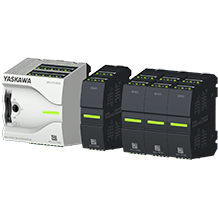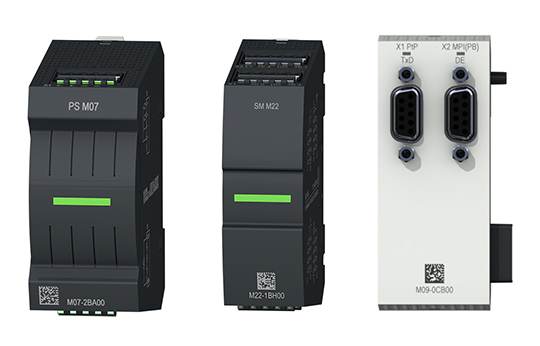

The new MICRO PLC – up to date, compact and fast
The design has a definite wow-factor and it opens up completely new paths as regards operating and status display. Thus the MICRO PLC is the starting signal for the new Yaskawa controller generation.
With its introduction the new MICRO PLC from Yaskawa launches a new product series and again raises the segment of the Yaskawa MICRO controllers to a new level. Designed as a stand-alone PLC it stands out because of its modern design, its compact size, its high performance, and its high channel density. Thus the user receives a multiplicity of performance in a very small space and at a very attractive price. The new MICRO PLC will replace the well-proven but aging System 100V.
Fast, faster, MICRO
In combination with this compactness the uniqueness of the new „MICRO“ is based on SPEED7 technology for the highest clock rates and fast program processing. With this, it makes fast processing possible, e.g. for precise positioning and diverse control tasks. Additional speed benefits allow a fast backplane bus transmission of 48 Mbit/s. With the CPU performance of a “large” CPU, the MICRO PLC is the fastest MICRO controller on the current controller market.
Design revolution
The design of the MICRO PLC contains a new display and operating concept that enables the user to see the essential control information of the system at a glance. For this, display and operating elements deliberately concentrate on the essentials that are required in practice. The result is an up-to-date and functional design which is unique in the world of automation.
The new “MICRO“– as the name suggests – is extremely compact. New solutions are therefore offered with regard to performance and space requirements and the optimization of size and the total costs. With a width of less than 72 millimeters the Yaskawa MICRO PLC is up to 50% smaller than typical MICRO controllers.
Highlights
High channel density
An additional plus factor is the high channel density of the “MICRO“. With 30 integrated digital and analog I/O channels on board it offers multifarious usage options as a stand-alone CPU too, and can be expanded with up to eight modules. For the product launch there will be digital modules (16DI, 16DO, 16DIO and 8 DO relay) available which will be expanded continuously by all well-established types of modules. By maximum module expandability, the user has up to 158 I/O channels available for his automation tasks.
Firm hold by spring terminal technology
The connection plugs of the “MICRO” are individually detachable and therefore suitable for the pre-wiring in the series launch. Equipped with the convenient push-in technology they can be mounted and replaced quickly and easily, and without tools. This reduces the down-times of the plants and systems and speeds up maintenance. In addition the plugs have spring terminals which not only allow easy wiring but also withstand every vibration. This makes the re-tightening of screw connections unnecessary.
Diagnosis made easily
The allocation of the I/O display LEDs directly on the appropriate plug connection allows the user an easy and clear allocation of the channel status even at such a high channel density. Additionally, the “MICRO” is equipped with an integrated web server, which allows arbitrary access via smartphone, laptop & Co. on data, diagnostics and status interfaces as well as freely definable visualization projects.
Interfaces, communication and memory
There is an active 2-port-switch for online access, programming, and communication. So the functional range of the “MICRO” can simply be extended by further planned features by means of a firmware update.
In addition to standard Ethernet protocols such as Modbus TCP or S7 communication, the “MICRO” also speaks PROFINET. This means that up to eight PROFINET devices can be easily connected and/or the “MICRO” can be integrated as an I-Device in PROFINET topologies. The user has also the option of using the PROFIBUS slave function, PtP and MPI with an expansion module. Further functionalities of the SLIO system such as larger memory or field bus connections can be enabled if necessary using the multiple award-wining VIPA Set Card (VSC), which is unique in the world of automation.
In the basic version, the “MICRO“ has 64 kByte work memory which can be expanded up to max. 128 kByte via VSC. A big advantage of the “MICRO”, and of all current VIPA CPUs, is the fully remanent memory. Data and status are therefore saved in the event of a power failure and no further safety measures are necessary. On the one hand this simplifies the program structuring and on the other hand it is an additional big benefit for producers and operators.
In addition, the compact Yaskawa small controller has following additional useful fetaures on board: SNTP, pulse train output, MRP client, PNIODiag FB126.
Target application
The new MICRO PLC can be used as a high-performance, small or micro controller in both serial and special machine construction as well as central or decentralized control in the field of plant construction. Of course, because of its compact construction size it is perfectly suitable for the building automation and the installation in sub-distributors.


